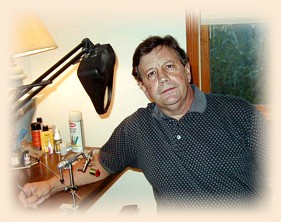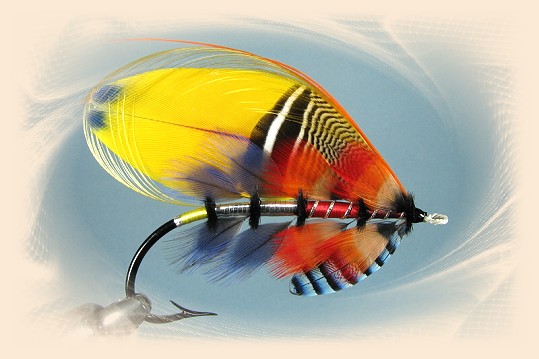A safer pilot through the shoals and quicksands
of the art than Major Traherne, or a more experienced
and practical exponent of its mysteries, cannot be found
within the 'three seas that girth Britain.' So says
H. Cholmondeley-Pennell regarding the depth of knowledge
of Major Traherne as it pertained to salmon in his book
Fishing from 1906. He thought so much
of Traherne's expertise that he included an article by him in
his book, the title of which was Salmon Fishing with
the Fly.
I found Traherne's article quite interesting and went right
to the "flies" section. When I think of Traherne I think of
his collection of patterns, one of which is the Evangeline
shown above, which feature large full feather wings, typically
made from macaw or parrot covert feather pairs. Sure enough,
in his article he talks about fishing the Shannon, and its
corresponding fly the Shannon, which features large wings
made from macaw coverts. Later in the article he says,
"Although big, gaudy flies are only suitable for big rivers,
I see no reason why they should not kill as well as any other pattern
upon smaller rivers, provided they are made of a suitable size. I have
said success greatly depends upon the size of the fly used, and to
judge the proper size is a most important part in the art of salmon fishing."
He doesn't limit himself to full wing flies at all though. "Large,
gaudy flies, such as are used on the Shannon, are not suitable for
ordinary-sized rivers, and are only good for fishing in deep rapids
of big rivers, where they are more likely to attract the attention of
fish than flies of more sombre or neutral colour." Here's
what he had to say about mixed wing flies: "Bought flies are
generally made with too much feather in the wing ; this is a great
mistake, especially in the case of a mixed wing. If the wing is too
heavy the fly cannot work properly ; every fibre of a mixed wing
should be separate in the water, and, if the angler does his work
properly, made to assume a natural and lifelike appearance."
Finally, Major Traherne has this to say about fly tying, and it mirrors
my own feelings on the subject so I will include the paragraph in its
entirety: "Fly tying is a very important part of the art of salmon
fishing, and doubtless to be able to tie one's own flies enhances the
pleasure of the sport. I have heard it said that a man cannot rank as
a first-class fisherman unless he can do so; but I think this is hardly fair.
Many people's fingers are 'all thumbs,' and they could not tie a fly in
a year of Sundays, as the saying goes; other salmon fishers are
professional men, and have no time to spare from their duties. These
may be first-rate fishermen, although not able to tie a fly, and would
loudly protest against being placed in a secondary position on this
account. It might just as well be said that to rank in the first class a
fisherman should be able to make his own rods and reels, yet there
is not one in a thousand that can do so. Fly tying is a most interesting,
and I might almost say exciting occupation, and many a dull rainy day,
during the winter months especially, may be thus pleasantly, and as far
as salmon-fishing matters are concerned profitably, passed. Doubtless
a man will feel much prouder when he has landed a fish with a fly of his
own making, than with one he had bought, and I would recommend
every fisherman who has the time to spare to try his hand at it."
Evangeline, the epic poem by Henry Wadsworth Longfellow, was
written in 1853. The fly is no doubt a tribute to that work as Major
Traherne spent quite a bit of time in Nova Scotia (Acadia) fly fishing.
It's a beautiful pattern for a beautiful poem. Here's the recipe:
Evangeline
Tag: Silver tinsel and topping colored silk
Tail: A topping
Butt: Black ostrich herl
Body: In four equal sections. First two: silver tinsel with
two blue chatterer substitutes above and below, back to back
with black herl butts. Third and fourth: Indian crow red and red
claret silks, with Indian crow substitutes above and below as
before and butted as before.
Ribs: Fine oval silver tinsel over the front two sections only.
Hackle: Golden yellow
Throat: A pair of Jay points back to back
Wings: Yellow macaw feathers (from the blue macaw)
and a topping over all.
Cheeks: Summer duck
Horns: Red macaw
Head: Black herl
Credits: Classic Salmon Flies by Mikael Frodin;
Salmon Fishing by John James Hardy.
About Eric:
 Eric lives in Delaware, Ohio and fishes for brown trout in the Mad River,
a beautiful spring creek. More of his flies are on display here:
traditionalflies.com -- Classic salmon and
trout flies of Europe and the Americas.
Eric lives in Delaware, Ohio and fishes for brown trout in the Mad River,
a beautiful spring creek. More of his flies are on display here:
traditionalflies.com -- Classic salmon and
trout flies of Europe and the Americas.
|


 Eric lives in Delaware, Ohio and fishes for brown trout in the Mad River,
a beautiful spring creek. More of his flies are on display here:
traditionalflies.com -- Classic salmon and
trout flies of Europe and the Americas.
Eric lives in Delaware, Ohio and fishes for brown trout in the Mad River,
a beautiful spring creek. More of his flies are on display here:
traditionalflies.com -- Classic salmon and
trout flies of Europe and the Americas.